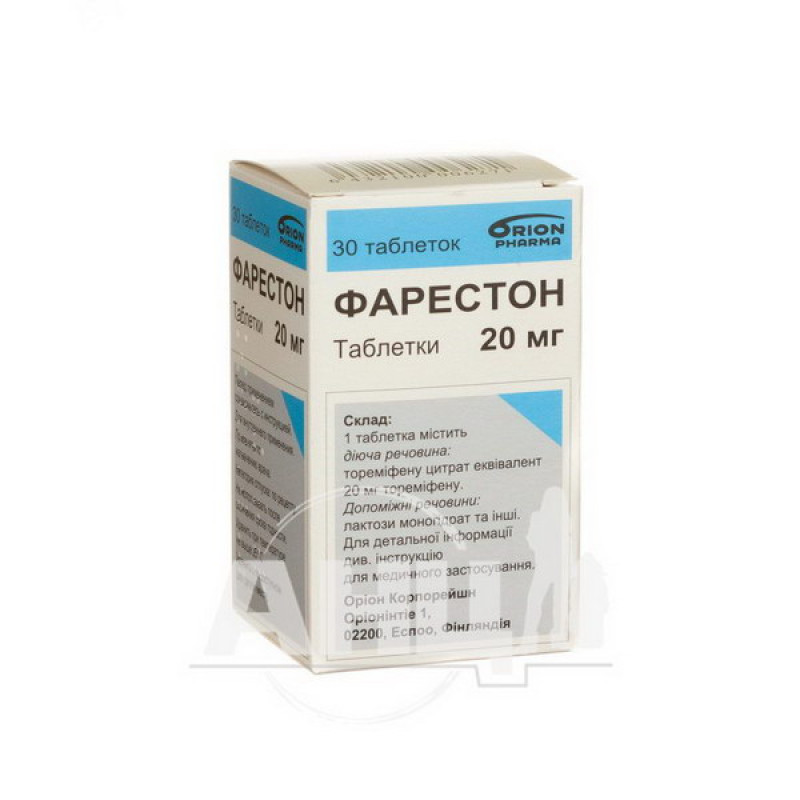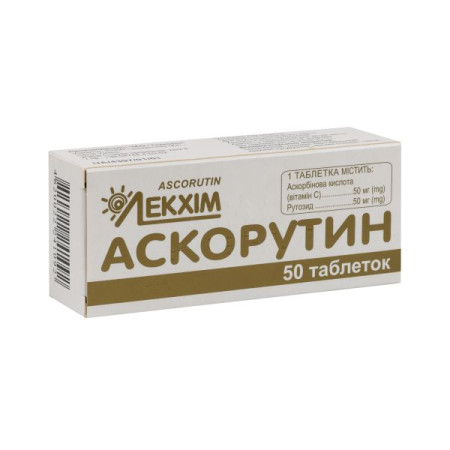Fareston tablets 20 mg bottle #30

Instructions Fareston tablets 20 mg bottle No. 30
Composition
active ingredient: 1 tablet contains toremifene citrate, equivalent to 20 mg or 60 mg of toremifene;
Excipients: corn starch, lactose monohydrate, povidone, sodium starch glycolate (type A), magnesium stearate, microcrystalline cellulose, colloidal anhydrous silicon dioxide.
Dosage form
Pills.
Main physicochemical properties:
20 mg tablets: white, almost white, round, flat, with beveled edges, marked TO 20 on one side;
60 mg tablets: white, almost white, round, flat, with beveled edges, marked TO 60 on one side.
Pharmacotherapeutic group
Antiestrogens.
ATX code L02B A02.
Pharmacological properties
Pharmacodynamics.
Toremifene is a nonsteroidal triphenylethylene derivative. Like other members of this class (e.g., tamoxifen and clomiphene), toremifene binds to estrogen receptors and exerts estrogen-like and/or antiestrogenic effects, depending on the duration of treatment, gender, target organ, and other characteristics.
Treatment of postmenopausal breast cancer patients with toremifene resulted in a modest reduction in serum cholesterol and LDL.
Toremifene competitively binds to estrogen receptors and inhibits estrogen-mediated stimulation of DNA synthesis and cell replication. In experimental cancer models, toremifene exerted an estrogen-independent antitumor effect at high doses.
The antitumor effect of toremifene on breast cancer is mediated by antiestrogenic action, but it cannot be excluded that other mechanisms (changes in oncogene expression, secretion of growth factors, induction of apoptosis and effects on cell cycle kinetics) may also exert an antitumor effect.
Pharmacokinetics.
Absorption. After oral administration, toremifene is rapidly absorbed. Peak plasma concentrations are determined on average after 3 (range 2-5) hours. Food does not affect the duration of absorption, but may delay peak concentrations by 1.5-2 hours. Changes associated with food intake are clinically insignificant.
Distribution. The concentration in blood plasma is described by a biexponential curve. The half-life in the first phase (distribution) is 4 (2-12) hours, in the second (elimination) -
5 (2-10) days. CL and V were not estimated due to the lack of intravenous infusion studies. More than 99.5% of toremifene binds to plasma proteins (albumin). The kinetics of toremifene in plasma when administered orally from 11 to 680 mg per day are linear. The average steady-state concentration of toremifene when taking the recommended dose
60 mg per day is 0.9 (0.6-1.3) mcg/ml.
Metabolism: Toremifene is extensively metabolized. The main metabolite in blood plasma is
N-dimethyltoremifene with a mean half-life of 11 (4-20) days. It has a similar antiestrogenic effect, but somewhat less than toremifene. More than 99.9% is bound to plasma proteins. Three other minor metabolites are detected in plasma: deaminohydroxytoremifene, 4-hydroxytoremifene, and N,N-didemethyltoremifene.
Elimination. Toremifene is eliminated primarily as metabolites in the feces. Enterohepatic recirculation may occur. More than 10% of the administered dose is excreted in the urine as metabolites. Due to slow elimination, steady-state plasma concentrations are reached within 4-6 weeks.
Indication
Treatment of hormone-dependent metastatic breast cancer in postmenopausal women as a first-line drug.
Prevention and treatment of dyshormonal breast hyperplasia.
Fareston is not recommended for patients with estrogen receptor-negative tumors.
Contraindication
A history of endometrial hyperplasia and severe hepatic insufficiency are contraindications to long-term use of toremifene.
Hypersensitivity to toremifene or to any of the excipients.
When using toremifene, changes in cardiac electrical conductivity were observed, namely, prolongation of the QT interval, therefore the drug is contraindicated in patients with:
– congenital or acquired prolongation of the QT interval;
– electrolyte imbalance, especially uncorrected hypokalemia;
– clinically significant bradycardia;
– clinically significant heart failure with reduced left ventricular ejection fraction;
– history of symptomatic arrhythmias.
Toremifene is not recommended for use with drugs that prolong the QT interval.
Interaction with other medicinal products and other types of interactions
An additive effect of QT prolongation cannot be ruled out when Fareston is used with other drugs that can prolong the QT interval. This may lead to an increased risk of ventricular arrhythmias, including flutter/fibrillation. Therefore, the simultaneous use of Fareston with the following drugs is contraindicated:
– class IA antiarrhythmic drugs (e.g. quinidine, hydroquinidine, disopyramide);
– class III antiarrhythmic drugs (e.g. amiodarone, sotalol, dofetilide, ibutilide);
– some antibacterial drugs (e.g. moxifloxacin, intravenous erythromycin, pentamidine, antimalarials, especially halofantrine);
– some antihistamines (e.g. terfenadine, astemizole, mizolastine);
– others (cisapride, vincamine IV, bepridil, diphemanil).
With simultaneous use of drugs that reduce renal calcium excretion (thiazide diuretics), the development of hypercalcemia is possible.
Inducers of hepatic enzyme systems (e.g. phenobarbital, phenytoin, carbamazepine) may accelerate the metabolism of toremifene in the liver and lead to a decrease in the equilibrium concentration of toremifene in the blood plasma. In this case, it may be necessary to double the daily dose.
Concomitant use of antiestrogens and warfarin-like anticoagulants may significantly increase bleeding time. Their concomitant use should be avoided.
Theoretically, some drugs that inhibit the CYP 3A enzyme system may slow down the metabolism of toremifene. This group of drugs includes antifungals - imidazole derivatives (ketoconazole) and other similar antifungal agents (itraconazole, voriconazole, posaconazole), protease inhibitors (ritonavir, nelfinavir), macrolides (clarithromycin, erythromycin and telithromycin). This fact should be taken into account when prescribing such drugs (e.g. ketoconazole, erythromycin, troleandomycin).
Application features
Before starting treatment, patients should undergo a gynecological examination. Particular attention should be paid to the condition of the endometrial mucosa. Then gynecological examinations should be repeated at least once a year. Patients with arterial hypertension, diabetes mellitus and a high body mass index (> 30) or who have received long-term hormone replacement therapy are at risk for endometrial cancer and therefore require careful monitoring.
Cases of anemia, leukopenia, and thrombocytopenia have been reported. Red blood cells, white blood cells, or platelets should be monitored when Fareston is used.
Cases of liver injury, including elevations of liver enzymes (>10 times the upper limit of normal), hepatitis and jaundice, have been reported with toremifene. Most of these cases occurred within the first months of treatment. The liver injury was predominantly hepatocellular in nature.
Toremifene is not recommended for the treatment of patients with a history of severe thromboembolic disease.
In some patients, Fareston may cause dose-dependent prolongation of the QT interval.
Fareston should be used with caution in patients with proarrhythmic conditions (especially in elderly patients), such as myocardial ischemia or QT prolongation, which may lead to an increased risk of ventricular arrhythmia (including flutter/fibrillation) and cardiac arrest. If symptoms that may be associated with cardiac arrhythmia occur during the use of Fareston, therapy should be discontinued and an ECG should be performed.
The drug should not be used if the QTc interval is > 500 ms.
Patients with decompensated heart failure or patients with severe angina require close monitoring.
Since patients with bone metastases may develop hypercalcemia at the beginning of treatment with the drug, these patients require careful monitoring.
There is no information on the use of the drug in patients with unstable diabetes, heart failure, or severe general condition.
The drug contains lactose (20 mg tablets - 19.0 mg/tablet, 60 mg tablets -
28.5 mg/tablet). In rare hereditary problems of galactose intolerance, the Lapp lactase deficiency or glucose/galactose malabsorption, the use of the drug is not indicated.
Use during pregnancy or breastfeeding
The drug is recommended for use in menopausal patients.
Fareston should not be used during pregnancy or breastfeeding due to a lack of information on its safety and effectiveness.
Ability to influence reaction speed when driving vehicles or other mechanisms
Usually the drug does not affect the reaction speed when driving or operating other mechanisms, but in rare cases dizziness may occur. In such cases, it is necessary to refrain from driving or operating other mechanisms.
Method of administration and doses
The drug is intended for oral use, regardless of meals.
Dyshormonal hyperplasia of the mammary gland.
The recommended dose is 20 mg per day.
Estrogen-dependent breast cancer.
For first-line hormone therapy, the recommended dose is 60 mg per day.
Kidney failure.
In renal failure, dose adjustment is not required.
Liver failure.
Toremifene should be administered with caution in patients with hepatic impairment.
Children
There is no information on the use of the drug in children, therefore the use of the drug in this category of patients is not indicated.
Overdose
Dizziness, headache, vertigo may occur when using the drug at a dose of 680 mg per day. It should also be taken into account that the prolongation of the QT interval may occur with overdose.
Overdose treatment is symptomatic; there is no specific antidote.
Adverse reactions
The most common adverse reactions are hot flashes, increased sweating, uterine bleeding, vaginal discharge, fatigue, nausea, rash, itching, dizziness, and depression. These adverse reactions are usually mild and are due to the antiestrogenic effect of toremifene.
The frequency of adverse reactions is classified as follows: very common (≥1/10);
common (≥1/100, <1/10); uncommon (≥1/1000, <1/100); rare (≥1/10,000 to <1/1000); very rare (<1/10,000), frequency unknown (cannot be estimated from the available data).
Benign and malignant neoplasms.
Extremely rare: endometrial cancer.
From the blood and lymphatic system.
Frequency unknown: thrombocytopenia, anemia, leukopenia.
From the side of metabolism and nutrition.
Uncommon: loss of appetite.
Mental disorders.
Common: depression.
Uncommon: insomnia.
From the nervous system.
Common: dizziness.
Uncommon: headache.
From the organs of vision.
Extremely rare: transient corneal opacity.
From the side of the hearing organs.
Rare: vertigo.
From the vascular system.
Very common: hot flushes.
Uncommon: thromboembolic episodes.
On the part of the respiratory system.
Uncommon: dyspnoea.
From the digestive tract.
Common: nausea, vomiting.
Uncommon: constipation.
On the part of the hepatobiliary system.
Rare: increased transaminase levels.
Extremely rare: jaundice.
Frequency unknown: hepatitis.
On the skin and subcutaneous tissue.
Very common: increased sweating.
Common: rash, itching.
Extremely rare: alopecia.
From the reproductive system.
Common: uterine bleeding, vaginal discharge.
Uncommon: endometrial hypertrophy.
Rare: endometrial polyps.
Extremely rare: endometrial hyperplasia.
General violations.
Common: fatigue, edema.
Uncommon: weight gain.
Hypersensitivity reactions.
Thromboembolic episodes include deep vein thrombosis, thrombophlebitis, and pulmonary embolism.
Toremifene treatment is associated with changes in liver enzyme levels (increased transaminase levels) and extremely rarely with severe liver dysfunction (jaundice).
Cases of hypercalcemia have been reported in patients with bone metastases at the beginning of therapy.
During toremifene therapy, endometrial hypertrophy may occur due to the partial estrogenic effect of toremifene. There is a risk of endometrial changes such as hyperplasia, polyposis and cancer. This may be due to the main mechanism of action of the drug - estrogenic stimulation.
QT interval prolongation with Fareston is dose-dependent.
Expiration date
5 years.
Storage conditions
Store at a temperature not exceeding 25 ° C. Keep out of the reach of children.
Packaging
20 mg – 30 tablets in a bottle; 1 bottle in a cardboard box;
60 mg – 30 tablets in a bottle; 1 bottle in a cardboard box.
Vacation category
According to the recipe.
Producer
Orion Corporation.
Location of the manufacturer and its business address
Orionintie 1, 02200 Espoo, Finland.
There are no reviews for this product.
There are no reviews for this product, be the first to leave your review.
No questions about this product, be the first and ask your question.




